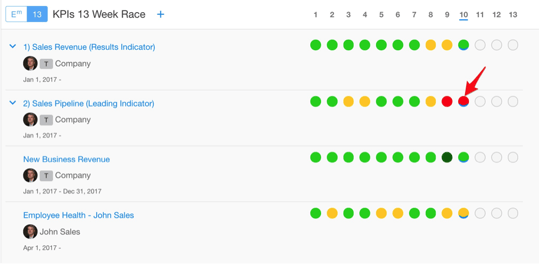I hear time and time again from people that their meetings are a complete waste of time. In fact, they can often be a huge productivity killer. When I dig deeper, I can easily find out why. They typically don’t accomplish anything - the team gets together, but they don’t work on solving the problems facing the company. Team members often update the status of their pet projects, highlighting their accomplishments and glossing over the challenges. Many people get the feeling of Groundhog Day as they talk about the same topics time after time and never make any progress on the real, pressing issues facing the company. However, they don’t get the comedic genius of the great Bill Murray to keep them entertained during their problem solving meeting. It doesn’t have to be that way. There is a better way to run weekly meetings to get real work done in their team meeting. It starts by framing them as a problem solving meeting so that your meeting has a purpose.
often be a huge productivity killer. When I dig deeper, I can easily find out why. They typically don’t accomplish anything - the team gets together, but they don’t work on solving the problems facing the company. Team members often update the status of their pet projects, highlighting their accomplishments and glossing over the challenges. Many people get the feeling of Groundhog Day as they talk about the same topics time after time and never make any progress on the real, pressing issues facing the company. However, they don’t get the comedic genius of the great Bill Murray to keep them entertained during their problem solving meeting. It doesn’t have to be that way. There is a better way to run weekly meetings to get real work done in their team meeting. It starts by framing them as a problem solving meeting so that your meeting has a purpose.
One of the easiest changes to your meeting is to attempt to solve at least one problem per week. Not just any problem, you should pick the most important problem facing your team each and every week. Think of all of the additional productivity you, your team, and your company could gain if you were able to put the team together and solve at least one problem per week. That’s an additional 52 problems you could solve each and every year, clearly putting you on the path to out-execute your competition and gain a competitive advantage in the marketplace.
At Rhythm Systems, our business KPI and OKR dashboards allow you to quickly and easily find the most important problems each week to solve. Since all of our key performance indicators (KPIs) and projects (Quarterly Priorities) have clear Red, Yellow, Green success criteria and are updated weekly by the owner, the team has a clear visual indicator of the business problems they are facing. Our clients can easily determine where there are problems, find the most important ones (as all KPIs and priorities/OKRs are ranked in order of importance), and brainstorm together on how to get back on track during their weekly adjustment meetings.
As you can see in our KPI dashboard below, we have a clear issue with our sales pipeline - a leading indicator for revenue. As this is a leading indicator, it helps the team predict revenue in the future; it gives us the added bonus of fixing the revenue problem BEFORE it shows up in the bottom line. To take your KPIs to the next level, follow these five tips to make sure your team is tracking the right KPIs - both leading and results indicators - successfully. It is extremely important to define the problem properly, so that you can get to the root cause of the issue.
Now that you have identified the problem to focus on, you can work deeply on the problem until you are able to devise and execute a complete game plan to solve it. If you follow our problem-solving meeting template below, you'll have the proper meeting agenda to help you break through any challenges you face. Use this as a primary agenda, but remember to allow team members to add an agenda item.
4-Step Process for a Problem Solving Meeting Agenda with This Problem-Solving Session Template (or Agenda).
Step One: List and brainstorm every potential cause for the problem or challenge.
- We want to make sure that we solve any structural issues first. These might be open sales positions, known bugs in the software, issues with a supplier - internal or external, known production issues, and those types of challenges. Do we have a standard and complete understanding of the problem? Is the meeting goal clear to everyone? This root cause analysis is an essential part of the process. If you don't find the root of the problem, it will feel like groundhog day as you'll solve the symptoms repeatedly.
Step Two: Brainstorm possible resources to help.
- During this step, think of the people and resources that might help you solve the problem. Are the resources in the room? Are they in the company? What are the budget constraints for a solution? In the sales pipeline example, the sales and marketing leader would likely need to be involved in solving the issue. This is critical to group problem solving: knowing where to get the necessary resources. You'll need to think of resources that might be outside the room. There needs to be a shared understanding of the root cause of the issue and all possible solutions to solve the problem.
Step Three: List and brainstorm every potential solution or approach.
- Think of as many ideas as you can. You might list an email blast to all of your prospects, a sales promotion to help with a sales pipeline issue, contracting an outside expert for search engine optimization, investing in more outbound sales representatives to schedule more meetings, and any other potential approach that is likely to solve the problem. This is where the team comes to a final decision on the recommended course of action or potentially two teams trying two different approaches.
Step Four: Recommendation for action.
- Discuss, Debate, and Agree on the course of action and execute against that plan. Discuss the plans entirely with the person who suggested them, taking the lead to explain their approach to the solution. Allow the team to debate the positive and negative merits of the proposal and repeat the process until all ideas have been presented. The team should be able to reach a consensus on the best course of action. Now the team can agree on the most likely solution (or two - if they are different resources) and create a game plan to execute against. Make sure that everybody on the team can answer the question "what is my role in the solution?" This action planning process ensures that you have an execution plan to solve the problem.
Move forward with your action plan and keep a constant and deliberate eye on your metrics and KPIs. If that isn't doing enough to move the needle to correct the problem, run through the process again, and determine additional steps to take to alleviate the issue. Keep working until you solve the problem. You can read more about different applications for the process here and download our free and handy Breakthrough to Green tool here.
However, many of you reading this post don't have a business dashboard solution already, so what can you do?
- Ask for any issues from the team when setting the agenda for your weekly meeting.
- If you are a manager, bring one of your problems to your team to have them help solve it with you. Making yourself human and vulnerable will encourage them to do the same with any issues they face.
- Work on solving problems, rather than placing blame, when discussing issues. Creating a safe environment for healthy discussions about things that are off track is crucial in solving problems in your business.
- Monitor your KPIs weekly and make sure significant projects get frequent (and honest) updates. If you wait too long between updates, you lose the ability to make the necessary adjustments if issues arise.
- Create a shared spreadsheet to start tracking your most important metrics and projects as a place to start. However, you might find that you'll outgrow your spreadsheet quickly; it is a place to get started and organize your thoughts.
- You're likely to have conflicting opinions, so ensure you set the proper ground rules for conduct and respect.
- Creative problem-solving isn't an event; it is a state of mind. You might not get it 100% right the first time, but with this problem-solving framework, you'll have the correct process to get to the desired solution.
Good luck taking your weekly staff meetings back and making them more productive! Download the free Breakthrough to Green tool to help you properly frame your problem and create an action plan to solve it. Thousands of teams have used this problem-solving process and can help yours too!
Additional Rhythm Systems Weekly Staff Meeting Resources:
How To Have Effective Weekly Staff Meetings (With Sample Agenda Template)
4 Easy Steps to Fix Your Weekly Staff Meetings [Video]
Download our weekly meeting agenda
Supercharge Your Meetings with This Effective Weekly Meeting Agenda
8 Ways to Make Weekly Meetings Strategic vs. Tactical (Video)
Weekly Adjustment Meetings vs. Weekly Status Meetings (Infographic)
Consider using Rhythm Software to run your weekly meeting, where the status and agenda are automatically created weekly to keep you on track!
Photo Credit: iStock by Getty Images
Photo Credit: iStock by Getty Images



 LinkedIn
LinkedIn
 Facebook
Facebook


